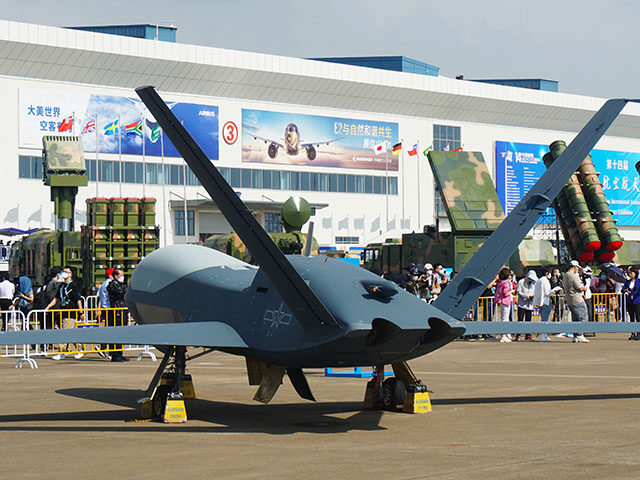Hu Xijin, ultra-nationalist former editor of China’s state-run Global Times, on Wednesday taunted that the United States would “definitely lose” a “war of drones” against the Communist tyranny he represents.
Hu was responding to comments by U.S. Indo-Pacific Command chief Adm. Samuel Paparo at the Shangri-La Dialogue defense forum. Paparo colorfully reiterated longstanding U.S. strategy to make unmanned air and sea vehicles a major element of Taiwan’s defense against a potential Chinese invasion.
“I want to turn the Taiwan Strait into an unmanned hellscape using a number of classified capabilities,” Paparao said, indicating that drones would be a major feature of that hellscape.
“I can make their lives utterly miserable for a month, which buys me the time for the rest of everything,” Paparo contended.
Until last year, U.S. defense planners believed they had an “asymmetric advantage” over China in drone warfare, especially in the context of blunting an invasion of Taiwan. The heavily fortified island is already tough to crack, and harassment by swarms of UAVs would make the job of the People’s Liberation Army Navy (PLAN) even harder as it tried to haul troops across the Taiwan Strait.
The Pentagon seemed to acknowledge that some adjustments in strategy were needed last summer when it rolled out the Replicator Initiative, a competitive program to build huge numbers of low-cost drones that could help to counter the sheer “mass” of the PLAN.
American UAVs tend to be sophisticated and expensive, while the “hellscape” strategy called for cheap drones that would probably have short lifespans on the Taiwan battlefield – a thicket of flying bombs that would make life extremely hazardous for Chinese amphibious and naval forces.
In March, the Pentagon committed a billion dollars to the Replicator initiative for the coming year.
“We’ll counter the PLA’s mass with mass of our own, but ours will be harder to plan for, harder to hit, harder to beat. With smart people, smart concepts, and smart technology, our military will be more nimble, with uplift and urgency from the commercial sector,” said Deputy Defense Secretary Kathleen Hicks.
Hu Xijin sneered that Paparo’s “hellscape” strategy is “actually a sign of cowardice” because the U.S. military is allegedly afraid to “dispatch troops to combat immediately,” unlike the PLA.
“Furthermore, the performance of U.S. drones in the Ukrainian battlefield is poor – much worse than Chinese drones,” he asserted.
Hu was probably alluding to a Wall Street Journal (WSJ) report in April that quoted Ukrainian and U.S. defense officials describing American-made small drones as “expensive, glitchy, and hard-to-repair.”
“Absent solutions from the West, Ukraine has turned to cheaper Chinese products to fill its drone arsenal,” the WSJ reported.
Part of the problem was that numerous American contractors were scrambling to provide the Pentagon with low-end drones after the Ukraine battlefield demonstrated their importance. Some of these providers complained that the U.S. regulatory environment put too many restrictions on their supply chains and testing programs, making development and production much too slow for the fast-moving Ukrainian battlefield – precisely the deficiency Hu singled out when he said the U.S. could never keep up with China in a clash of drones.
“If there is a war of drones, the U.S. military would definitely lose,” Hu boasted in his editorial. “Chinese drones are leading in materials, batteries, and software, and China has a huge production capacity for drones, with the industrial chain located domestically.”
Hu said these advantages allow China to mass-produce high-performance drones at very low prices, while the U.S. is struggling to catch up.
“Chinese experts have compared the Rogue-1 drone used by the U.S. military to a similar Chinese drone, and found that the Chinese drone costs only 5% of the price of the Rogue-1,” he said.
“China’s advantage lies in its scale, and the U.S. military’s attempt to confront China with their scale is clearly a wrong direction,” Hu concluded, using a favored Chinese idiom for making a big mistake.
The Rogue-1 is a kamikaze drone developed for the U.S. Marine Corps (USMC). Unlike many suicide drones, the Rogue-1 can be recalled and repurposed if its combat mission is canceled. Among other applications, the Marines hope to be able to launch them from unmanned surface vessels – a floating drone launching swarms of flying drones.
The developer, Teledyne FLIR Defense, is supposed to deliver 127 units of the drone to the USMC later this summer for a total price of $12 million, which works out to around $94,000 per drone.
China’s lowest-cost suicide drones are probably its knockoffs of Iran’s Shahed series, which the Russians have purchased in huge quantities for use against Ukraine. Russia reportedly paid about $290,000 apiece for its last big shipment of Shaheds, which included technology transfers and support equipment so the Russians could start manufacturing their own.
China’s Shahed competitor, the Sunflower-200, will reportedly cost about the same as the Rogue-1. If China can build a UAV with comparable range, endurance, and targeting sophistication for less than $5,000 apiece, the kids will all want one for Christmas. Then again, the goal of the Pentagon’s Replicator initiative is to figure out just how simple and inexpensive a drone can be, in order to create a “hellscape” for an amphibious invasion fleet, so even the Rogue-1 or Sunflower-200 might be a lot more drone than the Indo-Pacific Command really needs.

COMMENTS
Please let us know if you're having issues with commenting.